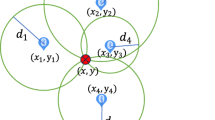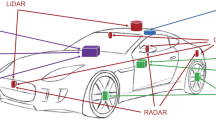Abstract
Real-time and accurate location detection is a key link to ensure the safety of operating machines and workers in production and life. Compared with traditional static multi-anchor nodes, mobile anchor node assisted localization is greener and more energy-saving. In this paper, we first propose a static trajectory based on a light reflection model. Compared with other static models, this model has fewer times in the field, overcomes the collinearity problem and uniform beacon distribution, and ensures that all sensor nodes can receive good enough beacon quality for localization. Secondly, an RSSI-based improved weighted centroid localization algorithm and an RSSI-based improved weighted centroid collaborative localization algorithm are proposed. The two-strategy optimal location beacon set screening method is used to reduce location misjudgment. In order to improve the accuracy of centroid localization, a weighted centroid localization algorithm based on distance and hop number is designed. Moreover, a collaborative localization strategy is aiming at improving beacon density. Experimental results show that both the algorithm and static trajectory can guarantee better beacon coverage rate and localization success rate under different experimental conditions, and at the same time have higher accuracy.














Similar content being viewed by others
References
Ghorpade, S. N., Zennaro, M., & Chaudhari, B. S. (2021). GWO model for optimal localization of IoT-enabled sensor nodes in smart parking systems. IEEE Transactions on Intelligent Transportation Systems, 22(2), 1217–1224.
Wang, M., & Zeng, J. (2022). Hierarchical clustering nodes collaborative scheduling in wireless sensor networks. IEEE Sensors Journal, 22(2), 1786–1798.
Wang, M., & Zhai, C. (2022). Node collaborative sensing-based redundant path construction for multi-area coverage in MWSNs. IEEE Internet of Things Journal, 9(11), 8763–8773.
Caceres Najarro, L. A., Song, I., & Kim, K. (2022). Fundamental limitations and state-of-the-art solutions for target node localization in WSNs: A review. IEEE Sensors Journal, 22(24), 23661–23682.
Huang, C. & Wang, M. (2022). Multi-stage low error localization based on krill herd optimization algorithm in WSNs. In Proceedings of the 2022 IEEE International Conference on Internet Things (iThings). (pp. 25–32) Espoo, Finland.
Li, Y., Li, B., Yu, W., Zhu, S., & Guan, X. (2022). Cooperative localization based multi-AUV trajectory planning for target approaching in anchor-free environments. IEEE Transactions on Vehicular Technology, 71(3), 3092–3107.
Sabale, K., & Mini, S. (2022). Path planning mechanism for mobile anchor-assisted localization in wireless sensor networks. The Journal of Parallel and Distributed Computing, 165, 52–65.
Halder, S., & Ghosal, A. (2016). A survey on mobility-assisted localization techniques in wireless sensor networks. Journal of Network and Computer Applications, 60, 82–94.
Yuan, B., He, R., Ai, B., Chen, R., Wang, G., & Di, J. (2022). A UAV-assisted search and localization strategy in non-line-of-sight scenarios. IEEE Internet of Things Journal, 9(23), 23841–23851.
Sabale, K., & Mini, S. (2021). Localization in wireless sensor networks with mobile anchor node path planning mechanism. Information Sciences, 579, 648–666.
Han, G., Jiang, J., Zhang, C., Duong, T. Q., Guizani, M., & Karagiannidis, G. K. (2016). A survey on mobile anchor node assisted localization in wireless sensor networks. The IEEE Communications Surveys and Tutorials, 18(3), 2220–2243.
Li, K., Shi, H., Wang, H., & Li, S. (2019). A mobile node localization algorithm based on an overlapping self-adjustment. Information Sciences, 481, 635–649.
Sabale, K., & Mini, S. (2021). Ransmission power control for anchor-assisted localization in wireless sensor networks. IEEE Sensors Journals, 21(8), 10102–10111.
Koutsonikolas, D., Das, S. M., & Hu, Y. C. (2007). Path planning of mobile landmarks for localization in wireless sensor networks. Computer Communications, 30(13), 2577–2592.
Han, G., Xu, H., Jiang, J., Shu, L., Hara, T., & Nishio, S. (2011). Path planning using a mobile anchor node based on trilateration in wireless sensor networks. Wireless Communications and Mobile Computing, 14(14), 1324–1336.
Huang, R. & Zaruba, G. V. (2007). Static path planning for mobile beacons to localize sensor networks. In Proceedings of the 15th Annual IEEE International Conference on Pervasive Computing and Communications Workshops (PerComW’07) (pp. 323-330) White Plains, NY, USA.
Han, G., Yang, X., Liu, L., Guizani, M., & Zhang, W. (2020). A disaster management-oriented path planning for mobile anchor node-based localization in wireless sensor networks. IEEE Transactions on Emerging Topics in Computing, 8(1), 115–125.
Rezazadeh, J., Moradi, M., Sandrasegaran, K., & Farahbakhsh, R. (2018). Transmission power adjustment scheme for mobile beacon-assisted sensor localization. The IEEE Transactions on Industrial Informatic, 15(5), 2859–2869.
Alomari, A., Comeau, F., Phillips, W., & Aslam, N. (2018). New path planning model for mobile anchor-assisted localization in wireless sensor networks. A Wireless Network, 24(7), 2589–2607.
Rezazadeh, J., Moradi, M., Ismail, A. S., & Dutkiewicz, E. (2014). Superior path planning mechanism for mobile beacon-assisted localization in wireless sensor networks. IEEE Sensors Journals, 14(9), 3052–3064.
Bulusu, N., Heidemann, J., & Estrin, D. (2000). GPS-less low cost outdoor localization for very small devices. IEEE Sensors Journals, 7(5), 28–34.
Shah, S. B. H., Zhe, C., Yin, F., Khan, I. U., & Faheem, M. (2018). 3D weighted centroid algorithm and RSSI ranging model strategy for node localization in WSN based on smart devices. Sustainable Cities and Society, 39, 298–308.
Dong, Q., & Xu, X. (2014). A novel weighted centroid localization algorithm based on rssi for an outdoor environment. Journal of Communication, 9(3), 279–285.
Phoemphon, S., So-In, C., & Leelathakul, N. (2018). Fuzzy Weighted Centroid Localization With Virtual Node Approximation in Wireless Sensor Networks. IEEE Internet of Things Journal, 5(6), 4728–4752.
Wang, M., Wang, X., Jiang, K., & Fan, B. (2022). Reinforcement learning-enabled resampling particle swarm optimization for sensor relocation in reconfigurable WSNs. IEEE Sensors Journals, 22(8), 8257–8267.
Yang, B., Qiu, Q., Han, Q., & Yang, F. (2022). Received signal strength indicator-based indoor localization using distributed set-membership filtering. IEEE Transactions on Cybernetics, 52(2), 727–737.
Facchinetti, G., & Ruostekoski, J. (2022). Interaction of light with planar lattices of atoms: Reflection, transmission and cooperative magnetometry. Physical Review A, 97(2), 023833.
Aghaei F., Eldeeb H. B. & Uysal M. (2023). A comparative evaluation of propagation characteristics of vehicular VLC and MMW channels. IEEE Transactions on Vehicular Technology, 1–10
Aghaei, F., Eldeeb, H. B., Bariah, L., Muhaidat, S., & Uysal, M. (2023). Comparative characterization of indoor VLC and MMW communications via ray tracing simulations. IEEE Access, 11, 90345–90357.
Xu, L., Li, Z., & Li, X. (2020). A hybrid approach using multistage collaborative calibration for wireless sensor network localization in 3D environments. IEEE Access, 8, 130205–130223.
Li, H., Yu, D., Hu, Y., & Yu, H. (2020). Improved trilateration centroid localization algorithm for wireless sensor network. Journal of Chinese Computer Systems, 41(6), 1216–1223.
Liu, Y., & Gao, M. (2018). Study of weighted centroid localization algorithm based on mobile anchor nodes. Transducer and Microsystem Technologies, 37(2), 150–153.
Acknowledgements
This work was supported in part by the National Natural Science Foundation of China under Grant 61971215 and in part by Scientific Research Fund of Hunan Provincial Education Department under Grant 21A0276.
Author information
Authors and Affiliations
Corresponding author
Additional information
Publisher's Note
Springer Nature remains neutral with regard to jurisdictional claims in published maps and institutional affiliations.
Rights and permissions
Springer Nature or its licensor (e.g. a society or other partner) holds exclusive rights to this article under a publishing agreement with the author(s) or other rightsholder(s); author self-archiving of the accepted manuscript version of this article is solely governed by the terms of such publishing agreement and applicable law.
About this article
Cite this article
Wang, M., Huang, C. Mobile anchor node assisted node collaborative localization based on light reflection in WSN. Wireless Netw (2024). https://doi.org/10.1007/s11276-024-03701-9
Accepted:
Published:
DOI: https://doi.org/10.1007/s11276-024-03701-9




